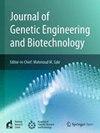Mitochondrial genetic markers based phylogenetic analyses of Hyalomma dromedarii Koch, 1844 (Acari: Ixodidae)
IF 2.8
Q3 Biochemistry, Genetics and Molecular Biology
Journal of Genetic Engineering and Biotechnology
Pub Date : 2025-01-27
DOI:10.1016/j.jgeb.2025.100460
引用次数: 0
Abstract
The hard tick Hyalomma dromedarii, a vector for numerous animal and human pathogens, was investigated for genetic diversity using the mitochondrial cytochrome C oxidase subunit I (cox I) and 16S ribosomal RNA (16S rRNA) genes. Hyalomma dromedarii sequences (n = 11 cox I; n = 7 16S rRNA) were deposited in GenBank (LC761179-89, LC761173-78, LC654692), showing 99.52–100 % (cox I) and 98.15–100 % (16S rRNA) similarity to existing GenBank sequences. Phylogenetic analysis revealed monophyletic clades for H. dromedarii sequences from this study and GenBank. Haplotype network analysis identified 34 and 11 haplotypes for the cox I and 16S rRNA genes, respectively, displaying stellate configurations. The overall cox I dataset showed very low nucleotide diversity (0.0019 ± 0.0002) and high haplotype diversity (0.535 ± 0.052). In contrast, the 16S rRNA gene dataset displayed low nucleotide (0.00211 ± 0.00071) and haplotype (0.351 ± 0.079) diversities. Neutrality tests showed significant negative values (Tajima’s D, Fu and Li’s D, and Fu and Li’s F), indicating recent population expansion or selective sweep. Pairwise FST values (−0.00942 to 0.02007 for cox I; −0.04878 to 0 for 16S rRNA) suggested non-significant genetic differentiation between populations, supported by high gene flow (Nm) values. This study provided novel insights into H. dromedarii population genetics, revealing recent expansion, weak population differentiation, and high gene flow. These findings have implications for understanding the tick’s evolutionary history and epidemiological significance.

基于线粒体遗传标记的dromedarii Koch, 1844的系统发育分析(蜱螨亚纲:伊蚊科)
利用线粒体细胞色素C氧化酶亚基I (cox I)和16S核糖体RNA (16S rRNA)基因,研究了硬蜱单峰透明眼(Hyalomma dromedarii)的遗传多样性。单眼透明瘤序列(n = 11 cox 1;在GenBank (LC761179-89, LC761173-78, LC654692)中,n = 7个16S rRNA序列与现有GenBank序列的相似性分别为99.52 - 100% (cox I)和98.15 - 100% (16S rRNA)。系统发育分析显示,本研究和GenBank的单系进化枝为单系进化枝。单倍型网络分析发现,cox 1和16S rRNA基因分别有34个和11个单倍型,呈星状构型。总体cox I数据集显示核苷酸多样性极低(0.0019±0.0002),单倍型多样性高(0.535±0.052)。相比之下,16S rRNA基因数据集显示低核苷酸(0.00211±0.00071)和单倍型(0.351±0.079)多样性。中性检验显示显著的负值(Tajima的D, Fu和Li的D,以及Fu和Li的F),表明最近的种群扩张或选择性清除。成对FST值(cox I为- 0.00942 ~ 0.02007;16S rRNA为- 0.04878 ~ 0),表明群体间的遗传分化不显著,这得益于较高的基因流(Nm)值。本研究揭示了单峰蝇种群的扩张、弱分化和高基因流等特征,为单峰蝇种群遗传学研究提供了新的思路。这些发现对了解蜱虫的进化史和流行病学意义具有重要意义。
本文章由计算机程序翻译,如有差异,请以英文原文为准。
求助全文
约1分钟内获得全文
求助全文
来源期刊

Journal of Genetic Engineering and Biotechnology
Biochemistry, Genetics and Molecular Biology-Biotechnology
CiteScore
5.70
自引率
5.70%
发文量
159
审稿时长
16 weeks
期刊介绍:
Journal of genetic engineering and biotechnology is devoted to rapid publication of full-length research papers that leads to significant contribution in advancing knowledge in genetic engineering and biotechnology and provide novel perspectives in this research area. JGEB includes all major themes related to genetic engineering and recombinant DNA. The area of interest of JGEB includes but not restricted to: •Plant genetics •Animal genetics •Bacterial enzymes •Agricultural Biotechnology, •Biochemistry, •Biophysics, •Bioinformatics, •Environmental Biotechnology, •Industrial Biotechnology, •Microbial biotechnology, •Medical Biotechnology, •Bioenergy, Biosafety, •Biosecurity, •Bioethics, •GMOS, •Genomic, •Proteomic JGEB accepts
 求助内容:
求助内容: 应助结果提醒方式:
应助结果提醒方式:


